
Felidae is the family of mammals in the order Carnivora colloquially referred to as cats. A member of this family is also called a felid. The term "cat" refers both to felids in general and specifically to the domestic cat.

The jaguar is a large cat species and the only living member of the genus Panthera native to the Americas. With a body length of up to 1.85 m and a weight of up to 158 kg (348 lb), it is the biggest cat species in the Americas and the third largest in the world. Its distinctively marked coat features pale yellow to tan colored fur covered by spots that transition to rosettes on the sides, although a melanistic black coat appears in some individuals. The jaguar's powerful bite allows it to pierce the carapaces of turtles and tortoises, and to employ an unusual killing method: it bites directly through the skull of mammalian prey between the ears to deliver a fatal blow to the brain.

The leopard is one of the five extant species in the genus Panthera. It has a pale yellowish to dark golden fur with dark spots grouped in rosettes. Its body is slender and muscular reaching a length of 92–183 cm (36–72 in) with a 66–102 cm (26–40 in) long tail and a shoulder height of 60–70 cm (24–28 in). Males typically weigh 30.9–72 kg (68–159 lb), and females 20.5–43 kg (45–95 lb).
Panthera is a genus within the family Felidae that was named and described by Lorenz Oken in 1816 who placed all the spotted cats in this group. Reginald Innes Pocock revised the classification of this genus in 1916 as comprising the tiger, lion, jaguar, and leopard on the basis of common cranial features. Results of genetic analysis indicate that the snow leopard also belongs to the genus Panthera, a classification that was accepted by IUCN Red List assessors in 2008.
The term "big cat" is typically used to refer to any of the five living members of the genus Panthera, namely the tiger, lion, jaguar, leopard, and snow leopard, as well as the non-pantherine cheetah and cougar.

Dinofelis is an extinct genus of sabre-toothed cats, possibly a member of the tribes Metailurini. They were widespread in Europe, Asia, Africa and North America from 5 million to about 1.2 million years ago. Fossils very similar to Dinofelis from Lothagam range back to around 8 million years ago, in the Late Miocene.
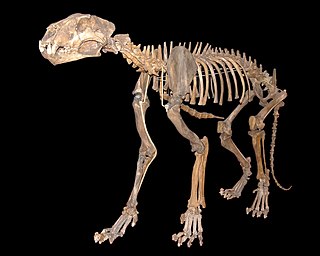
Panthera spelaea, also known as the Eurasian cave lion, European cave lion or steppe lion, is an extinct Panthera species that most likely evolved in Europe after the third Cromerian interglacial stage, less than 600,000 years ago. Phylogenetic analysis of fossil bone samples revealed that it was highly distinct and genetically isolated from the modern lion occurring in Africa and Asia.

Panthera atrox, better known as the American lion, also called the North American lion, or American cave lion, is an extinct pantherine cat. Panthera atrox lived in North America during the late Pleistocene epoch and the early Holocene epoch, from around 340,000 to 11,000 years ago. The species was initially described by American paleontologist Joseph Leidy in 1853 based on a fragmentary mandible (jawbone) from Mississippi; the name means "savage" or "cruel". The status of the species is debated, with some mammalogists and paleontologists considering it a distinct species or a subspecies of Panthera leo, which contains living lions. However, novel genetic evidence has shown that it is instead from a sister lineage with the cave lion, evolving after its geographic separation. Its fossils have been excavated from Alaska to Mexico. It was about 25% larger than the modern lion, making it one of the largest known felids.

Pantherinae is a subfamily within the family Felidae; it was named and first described by Reginald Innes Pocock in 1917 as only including the Panthera species. The Pantherinae genetically diverged from a common ancestor between 9.32 to 4.47 million years ago and 10.67 to 3.76 million years ago.
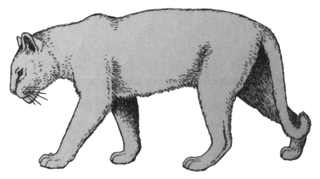
Panthera gombaszoegensis, also known as the European jaguar, is a Panthera species that lived from about 2.0 to 0.35 million years ago in Europe. The first fossils were excavated in 1938 in Gombasek, Slovakia.

Panthera fossilis, is an extinct species of cat belonging to the genus Panthera, known from remains found in Eurasia spanning the Middle Pleistocene and possibly into the Early Pleistocene. P. fossilis has sometimes been referred to by the common names steppe lion or cave lion, though these names are conventionally restricted to the later related species P. spelaea, to which P. fossilis is probably ancestral.
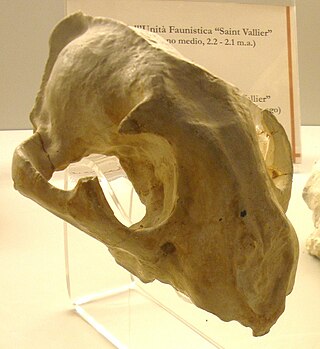
Puma pardoides, sometimes called the Eurasian puma or Owen's panther, is an extinct prehistoric cat. It was long regarded as a primitive species of leopard. Recent work however has shown that Panthera pardoides and Panthera schaubi are actually the same species, and are probably not pantherine at all, but a member of Felinae related to the cougar, making them more properly classified as Puma pardoides.
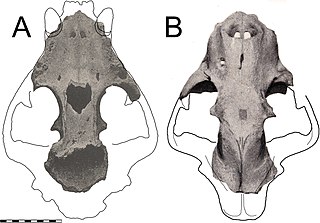
Panthera onca mesembrina is an extinct subspecies of jaguar that was endemic to Patagonia in southern South America during the late Pleistocene epoch. It is known from several fragmentary specimens, the first of which found was in 1899 at "Cueva del Milodon" in Chile. These fossils were referred to a new genus and species "Iemish listai" by naturalist Santiago Roth, who thought they might be the bones of the mythological iemisch of Tehuelche folklore. A later expedition recovered more bones, including the skull of a large male that was described in detail by Angel Cabrera in 1934. Cabrera created a new name for the giant felid remains, Panthera onca mesembrina, after realizing that its fossils were near-identical to modern jaguars’. P. onca mesembrina's validity is disputed, with some paleontologists suggesting that it is a synonym of Panthera atrox.
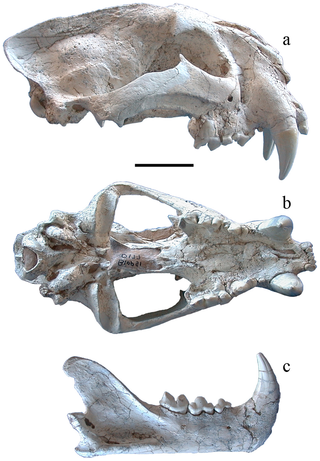
Panthera zdanskyi, is an extinct pantherine species that is seen as a close relative of the modern tiger. Fossils were excavated in northwestern China's Gansu province.
Panthera tigris acutidens or Wanhsien tiger is an extinct tiger subspecies, which was scientifically described in 1928 based on fossils excavated near Wanhsien in southern China's Sichuan Province. Otto Zdansky named it Felis acutidens. After the fossils were re-examined in 1947, they were attributed to Panthera tigris acutidens by Dirk Albert Hooijer and Walter W. Granger.

Panthera blytheae is an extinct species of pantherine felid that lived during the late Messinian to early Zanclean ages approximately 5.95–4.1 million years ago.The first fossils were excavated in August 2010 in the Zanda Basin located in the Ngari Prefecture on the Tibetan Plateau; they were described and named in 2014.
Panthera shawi is an extinct prehistoric cat, of which a single canine tooth was excavated in Sterkfontein cave in South Africa by Robert Broom in the 1940s. Broom described it in 1948 using the scientific name Felis shawi. It is thought to be the oldest known Panthera species in Africa.
Miopanthera is an extinct genus of Pseudaelurus-grade felids.

Panthera balamoides is a species described as an extinct species of the big cat genus Panthera that is known from a single fossil found in a Late Pleistocene age cenote in the Yucatan Peninsula, Mexico. P. balamoides has only a single reported specimen, the distal end of a right humerus, that is notably of exceptional size for a felid. It was unearthed in 2012 from an underwater cave and described in 2019 by an international group of paleontologists from Mexico and Germany led by Sarah R. Stinnesbeck. However, several authors have since proposed that the fossil comes from an ursid, possibly the extinct Arctotherium, and not of felid affinities.
Panthera principialis is an extinct species in big cat genus Panthera described in 2023 based on fragmentary Pliocene-aged fossils from Laetoli, Tanzania. As the species was the oldest known Panthera species at the time, it was given the specific epithet "principialis", from the Latin word meaning "initial, original, in the beginning".













